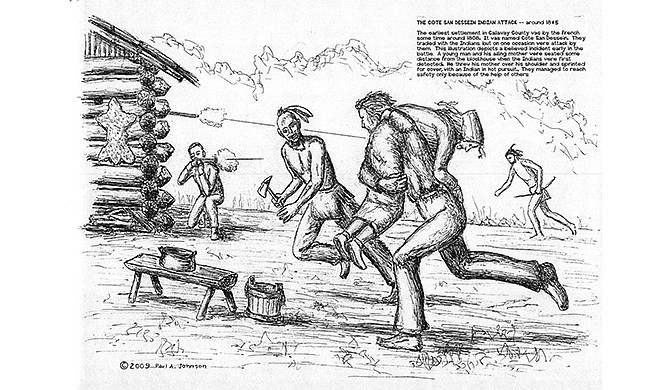Untouched prairies and dense forests covered Mid-Missouri when French-Canadian fur traders established Cote sans Dessein more than 200 years ago.
Bears, buffalo, beavers, mountain lions and cougars roamed as freely as deer and groundhogs still do today.
In 1808, the village opposite the mouth of the Osage River and about 12 miles down the Missouri River from Jefferson City was the western-most permanent settlement in the United States.
These frontiersmen, with their wives and children, had good rapport with the native people - mostly Osage - in the area and were not strangers to rugged living.
But on April 4, 1815, the village faced an uncommon foe. Warriors from the Illinois Sac tribes, aided by Ioway and Fox, attacked Cote sans Dessein, despite their British allies' signing the Treaty of Ghent four months earlier, ending the War of 1812.
The Louisiana Territory included land that had been part of the indigenous hunting grounds for generations of Osage, Sac, Iowa, Fox, Missouri and other tribes. However, some tribes did not like the encroachment of the European settlements onto their land. By becoming allies with the British, the Illinois Sac and Fox expected the villagers would move back east.
In seven years, the village had grown to about 20 families.
The battle
The Illinois Sac, Fox and Ioway warriors numbered up to 200 when they attacked Cote sans Dessein on this day 200 years ago. This was not the first raid along the Missouri River settlements, but it was one of the largest.
The traders, merchants, farmers and families at Cote sans Dessein were not caught completely by surprise. The natives' raids had been on the increase for the last year of the war, and the U.S. military was not equipped to deal with such remote places as the frontier.
Like many of the settlements from St. Charles to Fort Osage, Cote sans Dessein built fortifications. There were two forts, each with a blockhouse.
On that day in 1815, Joseph Roi, one of four brothers who founded the settlement, discovered the Sac war party while he was hunting nearby. He quickly rode back to warn his village. Most of the men grabbed their weapons and ran out to meet the native attackers, while the women, children and young slaves retreated to the larger Thibault's Fort or smaller Roi's Fort.
A party of about 50 Illinois Sac, Fox and Ioway sneaked around the battle to enter the fort stockade. They killed and mutilated a father and son. But another son was noted for his bravery, when he carried his invalid mother on his shoulders into the safety of the blockhouse.
Capt. Etienne Coursault, one of three known militiamen there that day, was killed in the woods during the fighting that lasted most of the afternoon.
The remainder of this day's legend centers at the Roi blockhouse.
Louis Roi had stayed behind to clean his rifle. Some accounts lean as though he was avoiding the skirmish, while others suggest he anticipated such a village raid.
Whatever his motivations, the expert marksman was able to fire so rapidly the attackers were convinced there were more men inside. In fact, there were five other women who were busy tearing cloth, moulding lead bullets and loading rifles for Roi.
Eventually discouraged, the Illinois Sac, Fox and Ioway retreated to a ravine at the river's edge, out of range of Roi's rifle. Then they shot fiery arrows onto the roof. The women, including Louis Roi's wife, Julia, took turns climbing the ladder to douse the fire with what little water they had inside. When that was exhausted, they turned to buttermilk from the cupboard.
After another volley of fire, Julia Roi produced a used bedpan to continue dousing the flames on the roof. And the women took turns refilling it until the attackers gave up and turned their attention to the log powder magazine between the forts.
This they also set on fire and soon it exploded, killing several of the natives and throwing more into the Missouri River.
At the end of the day, the village had lost five men, and reasonable accounts say 14 Native Americans were killed.
Aftermath
The raiding continued along the riverway, causing many from the village to move out. The Illinois Sac and Fox did not sign a peace treaty until May 1816.
After that, land speculators, including Thomas Hart Benton and Angus Lewis Langham, began to take notice of Cote sans Dessein's potential.
The village grew steadily. When Missouri sought the location for its permanent seat of government in 1822, Cote sans Dessein was not only the preferred choice, it was the only sizable settlement within the parameters of being less than 40 miles from the Osage River.
If it were not for faulty paperwork stemming from the Spanish land grants in the late 1700s and some misuse of land grants for victims of the New Madrid earthquake, Jefferson City likely would not exist and the Capitol would have been built at Cote sans Dessein, some historians say.
Today, the location of the original of three Cote sans Dessein villages has been removed by change in the river's flow and a manmade levy. The larger of the two forts, Thibault's Fort, likely was located on top of the hill - namesake of the French Hill Without Design. But, in the mid-20th century, that location was erased by quarrying.

